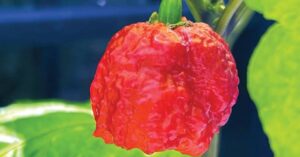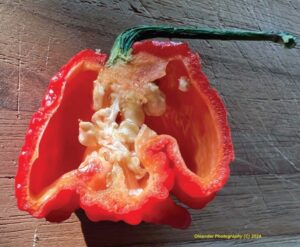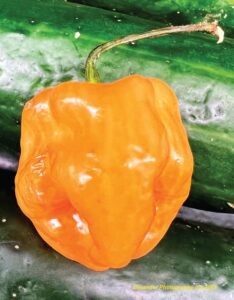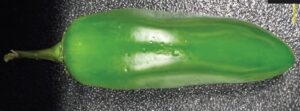“How bad could it be?” was the last thought before I took a small bite of the Carolina Reaper pepper I had grown in my (toxicology-required) garden. “Am I going to die?” was the next thought as I swigged milk to extinguish the blowtorch in my mouth, mopped sweat off my forehead, tried not to retch, and rethought recent life-choices.

The Carolina Reaper pepper.
Chili peppers (Capsicum species; Greek Kapto, “to bite”) are thought to have been domesticated in central and south America in about 10,000 BCE. There are five primary species used commercially and are upright annual shrubs with dark green ovoid leaves that produce small white to yellow flowers that develop into round or elongated fruits. Because of the heat sensation they provide, they feature prominently as a key food ingredient in Latin American, African, and Asian cuisines. India and China are primary suppliers of chilies in the world.

A cross-section of the Carolina Reaper.
The chili pepper plants belong to the family Solanaceae which includes the genus Solanum (nightshade, tomato, potato); Nicotiana (belladonna, jimsonweed, tobacco); and Capsicum (including hot peppers and bell).
The basic references to this plant are confusing and include “peppers” and “chili” (also spelled chile or chilli). Chili peppers are not actually ‘peppers’ (e.g., black pepper (Piper nigrum), which are berries that contain spicy piperine) but are the fruits of capsicum plants (originating from Central and South Americas and contain capsaicin). The misattribution began when they were brought back to Spain in the 15th century by Christopher Columbus from the West, and he called them ‘peppers’ because of its similar effects on his tongue and the name stuck.1 Adding more confusion, some countries refer to these fruits as ‘peppers’ when they are fresh and ‘chilies’ when they are dried.

A habanero pepper.
Carolina Reaper, under whose effects I was suffering, is a cultivar of (Capsicum chinense) and was declared in 2013 to be the hottest chili pepper in the world with greater than 1.6 million Scoville units. It was developed by Ed Currie (founder of Puckerbutt Pepper Co.), who considers hot pepper cultivation one of his life’s goals and a factor in his sobriety from a substance use disorder—in part because of capsaicin’s induction of endorphin release.
Chili peppers’ pungency (spicy heat) when ingested or applied topically is due to capsaicin (8-methyl-N-vanillyl-6-nonenamide, (C18H27NO3)) and several related chemicals, as a group called capsaicinoids. Humans perceive each capsaicinoid differently. Nordihydrocapsaicin’s sensation is described as “warm” and “least irritating,” which recedes rapidly; capsaicin and dihydrocapsaicin are described as “irritating,” and produce heat in the mouth, palate, and throat; and homodihydrocapsaicin is described as very “irritating, harsh, and very sharp,” affecting the back of the mouth and throat which comes on slowly and lasts a long time. Combinations of these toxins produce different heat profiles of different chilis.2

A jalapeno pepper.
The concentration of these chemicals determines degree of the sensation and depends not only on the kind of chili, but on other factors including what part of the fruit you eat—the hottest part is the placenta (white part in the middle), followed by the flesh (exocarp, mesocarp, endocarp) and the seeds; fruit maturity and water content of the chili also affect pungency (unripe—ripe—dried).
In nature, the capsaicin is primarily used by the plant for defense to inhibit herbivorous mammals from eating it—the spice does not affect birds who eat the fruit and spread the seeds.
Capsaicinoids are irritants and inflammatory molecules that interact with transient receptor potential vanilloid 1 (TRPV1) that reside on the ends of nociceptive A-delta and C- sensory fibers. These receptors are activated by capsaicinoids, noxious heat (greater than 109.4 degress Fahrenheit), caustics (low pH), and voltage—causing a Ca++ and Na+ action potential influx that confers the sensation of pain and burning to the brain. They are found in large numbers in the mouth, throat, and stomach, as well as throughout the body.3
Capsaicin and the capsaicinoids are not detected by our taste buds and have no flavor—not salt, bitter, sweet, sour, or umami. They create a chemesthesis stimulus we interpret as “spiciness,” which is a multimodal somatic sensation (not just taste, olfaction, pain, temperature, or itch). The resultant “heat” we feel after exposure is not thermally hot (a thermometer in my scorched mouth would read normal), but a result of the cross-stimulation of these vanilloid molecules binding to a thermal receptor—the sensory experience transmitted centrally is interpreted as ‘burning.4
Despite not being a taste, a five part standardized lexicon for chili pepper hotness exists:1
- Development (how fast it comes on)
- Duration (how long the burn lasts)
- Location (where in mouth/throat)
- Feeling (“sharp” vs. “flat” heat)
- Intensity (analytically measured heat level)
Capsaicin has a unique attribute among natural irritants—the excitation it evokes is followed by a period of decline or cessation in sensory transmission (called defunctionalisation) for a variety of other stimuli. This attribute is exploited by frequent eaters of spicy foods (they don’t feel it as much as novices), and pharmaceutical products.5
The human response to capsaicin exposure ranges from enhancing food enjoyment to uncomfortable to unbearable depending on the dose of exposure and resultant receptor agonism. Oral exposure creates a spicy burning sensation (or pungency) in the mouth that can extend to the throat and stomach (and eventually the rectum—“fire tuchus”). This is frequently accompanied by diaphoresis, facial flushing, lacrimation, and rhinorrhea. Higher dose exposures to the irritant can result in nausea, vomiting, chest, and abdominal pain.
Topical exposures to the skin can cause burning sensation, erythema, and transient numbness; high dose exposure to the hands while cooking has a well-described syndrome of ‘Hunan hand’ which presents with severe pain in the fingers after chopping chili peppers.6 Inadvertent exposure to the eyes can result in severe pain, lacrimation, visual blurring, conjunctival injection, lid swelling; corneal injuries are possible.
Capsaicin pepper exposures send about 300-350 people to the hospital annually.7 Boerhaave syndrome was described in a 47-year-old man after eating ghost pepper.8 Seizures and thunderclap headache from reversible cerebral vasoconstriction syndrome have been reported.8,9 There is one case of a 17-year-old who died from acute cerebellar stroke after participating in the “One Chip Challenge” (eating a capsaicin infused food chip as a game) that prompted Hershey Co. to recall the product.11 Pepper spray (oleoresin capsicum) is also used by law enforcement (and others) as non-lethal means of defense and results in about 600 hospital visits annually after exposure with eyes being most common site of injury.7,12
It is used primarily for control pain with application of capsaicin containing compounds. The purported effect is an overstimulation of the pain fibers that eventually become transiently unresponsive. Capsaicin is used in alternative or adjunctive medicine for many maladies including—Topically: uremic pruritus, post-herpetic neuralgia, osteoarthritis pain, cannabinoid induced hyperemesis; intravesical instillation: overactive bladder syndrome; intranasal capsaicin spray for rhinitis; oral rinses for burning mouth syndrome, among others.13
Treatment is generally supportive with copious irrigation for dilution as a mainstay. For ingestions there are many suggested techniques to assist with severe burning oral and throat pain. Effective agents include: milk and dairy products, which contain casein that works to breaks down capsaicin (found in whole, skim milk, ice cream), high sugar drinks (Kool Aid), and cooling the mouth with cold drink or ice.
Topical exposures (pepper sprays, etc.) should be washed off the face using copious water (adding mild dish detergent may help). Ocular exposures are managed with contact lens removal and application of topical anesthetic, flushing eyes with water or saline for at least 15 minutes. Referral for ophthalmology for patients with signs of corneal damage. The airway should be evaluated for bronchospasm and swelling, with supplementary oxygen or inhaled bronchodilators given if necessary.
After experiencing a burning mouth (that interestingly felt worse when I exhaled and improved when I inhaled), drenching scalp sweat, rhinorrhea, forearm piloerection, that lasted for about one hour, the sensation began to abate. Using the proposed lexicon, I would rate the experience as follows:
- Development: 8 seconds of peace before agony arrived
- Duration: 45-60 minutes
- Location: it was unescapably everywhere
- Feeling: very very sharp heat
- Intensity: the hottest pepper in the world—I agree.
 Dr. Hack is chief of the division of medical toxicology and vice chair for research at East Carolina University in Greenville, North Carolina.
Dr. Hack is chief of the division of medical toxicology and vice chair for research at East Carolina University in Greenville, North Carolina.
- Barboza GE, García CC, et al. An amazing new Capsicum (Solanaceae) species from the Andean-Amazonian piedmont. PhytoKeys. 2020;167:13-29.
- Guzmán I, Bosland PW. Sensory properties of chile pepper heat – and its importance to food quality and cultural preference. Appetite. 2017;117:186-190.
- Rosenbaum T, Simon SA. Chapter 5. TRPV1 receptors and signal transduction. In: Liedtke WB, Heller S, eds. TRP ion channel function in sensory transduction and cellular signaling cascades. Boca Raton (FL): CRC Press/Taylor & Francis; 2007. Available from: https://www.ncbi.nlm.nih.gov/books/NBK5260/. Accessed March 26, 2024.
- Shuba YM. Beyond neuronal heat sensing: diversity of TRPV1 heat-capsaicin receptor-channel functions. Front Cell Neurosci. 2021;14:612480.
- Sharma SK, Vij AS, et al. Mechanisms and clinical uses of capsaicin. Eur J Pharmacol. 2013;720(1-3):55-62.
- Weinberg RB. Hunan hand. N Engl J Med. 1981;305(17):1020.
- Gummin DD, Mowry JB, et al. 2022 annual report of the National Poison Data System® (NPDS) from America’s Poison Centers®: 40th annual report. Clin Toxicol (Phila). 2022;61(10): 717-939.
- Arens A, Ben-Youssef L, et al. Esophageal rupture after ghost pepper ingestion. J Emerg Med. 2016;51(6):e141-e143.
- Healy VO. Orland Park man credits hot sauce with saving his life. Chicago Tribune. March 13, 2015. Available at: https://www.chicagotribune.com/2015/03/13/ orland-park-man-credits-hotsauce-with-saving-his-life/. Accessed March 26, 2024.
- Boddhula SK, Boddhula S, et al. An unusual cause of thunderclap headache after eating the hottest pepper in the world – “The Carolina Reaper”. 2018. BMJ Case Rep. 2018:bcr-2017- 224085.
- Wikipedia contributors. One Chip Challenge. Wikipedia, The Free Encyclopedia. Available at: https://en.wikipedia.org/wiki/One_Chip_Challenge. Last updated March 22, 2024. Accessed March 26, 2024.
- Kearney T, Hiatt P, et al. Pepper spray injury severity: ten-year case experience of a poison control system. Prehosp Emerg Care. 2014;18(3):381-6.
- Catalfamo LM, Marrone G, et al. The utility of Capsicum annuum L. in Internal Medicine and In Dentistry: A Comprehensive Review. Int J Environ Res Public Health. 2022;19(18):11187.










